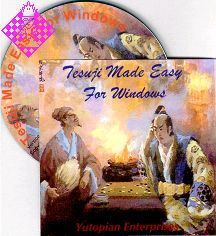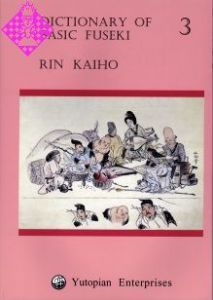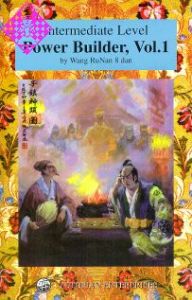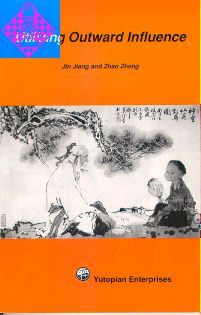Article Number
LGJIAUOI
Utilizing Outward Influence
142 pages, paperback, Yutopian, 1. edition 1995
Discontinued
Go - Life, Liberty, and the pursuit of Territory through Connection and Influence. Each player seeks to discover the strategy and tactics necessary to acquire the most territory. Ideally each move should pose multiple threats to create or destroy Life, Connection, Influence, and/or Territory.
Influence directed away from the edge of the board (outward influence) consists of long (broad) or short (narrow) strings of stones that cannot be disconnected (thickness) or that can be disconnected (thinness). The range of influence (power) of outward influence is measured by its direction, broadness, narrowness, thickness, and/or thinness. Utilizing Outward Influence by Jin Jiang and Zhao Zheng provides a study of how to efficiently build and use outward influence.
Numerous examples of how to construct thickness and how to avoid thinness are given. Also included are abundant examples of sacrifice and ko tactics that can be used for constructing large territory frameworks (moyos) from outward influence.
Seizing control of the center is vital for gaining the most territory. Additional examples of using pivot points (an intersection on the edge of opposing moyos which, upon occupation by one side, will expand that sides moyo and reduce the opposing moyo) for seizing control of the center are provided.
Utilizing Outward Influence is a book to help one reach shodan strength by reviewing the tactics and strategies used by dan players. Fifty (50) problems and over fifty (50) examples are included which address: how to create thickness and avoid thinness in building outward influence; using outward influence to create moyos; and using outward influence to create territory by attacking.
Influence directed away from the edge of the board (outward influence) consists of long (broad) or short (narrow) strings of stones that cannot be disconnected (thickness) or that can be disconnected (thinness). The range of influence (power) of outward influence is measured by its direction, broadness, narrowness, thickness, and/or thinness. Utilizing Outward Influence by Jin Jiang and Zhao Zheng provides a study of how to efficiently build and use outward influence.
Numerous examples of how to construct thickness and how to avoid thinness are given. Also included are abundant examples of sacrifice and ko tactics that can be used for constructing large territory frameworks (moyos) from outward influence.
Seizing control of the center is vital for gaining the most territory. Additional examples of using pivot points (an intersection on the edge of opposing moyos which, upon occupation by one side, will expand that sides moyo and reduce the opposing moyo) for seizing control of the center are provided.
Utilizing Outward Influence is a book to help one reach shodan strength by reviewing the tactics and strategies used by dan players. Fifty (50) problems and over fifty (50) examples are included which address: how to create thickness and avoid thinness in building outward influence; using outward influence to create moyos; and using outward influence to create territory by attacking.
Go - Life, Liberty, and the pursuit of Territory through Connection and Influence. Each player seeks to discover the strategy and tactics necessary to acquire the most territory. Ideally each move should pose multiple threats to create or destroy Life, Connection, Influence, and/or Territory.
Influence directed away from the edge of the board (outward influence) consists of long (broad) or short (narrow) strings of stones that cannot be disconnected (thickness) or that can be disconnected (thinness). The range of influence (power) of outward influence is measured by its direction, broadness, narrowness, thickness, and/or thinness. Utilizing Outward Influence by Jin Jiang and Zhao Zheng provides a study of how to efficiently build and use outward influence.
Numerous examples of how to construct thickness and how to avoid thinness are given. Also included are abundant examples of sacrifice and ko tactics that can be used for constructing large territory frameworks (moyos) from outward influence.
Seizing control of the center is vital for gaining the most territory. Additional examples of using pivot points (an intersection on the edge of opposing moyos which, upon occupation by one side, will expand that sides moyo and reduce the opposing moyo) for seizing control of the center are provided.
Utilizing Outward Influence is a book to help one reach shodan strength by reviewing the tactics and strategies used by dan players. Fifty (50) problems and over fifty (50) examples are included which address: how to create thickness and avoid thinness in building outward influence; using outward influence to create moyos; and using outward influence to create territory by attacking.
Influence directed away from the edge of the board (outward influence) consists of long (broad) or short (narrow) strings of stones that cannot be disconnected (thickness) or that can be disconnected (thinness). The range of influence (power) of outward influence is measured by its direction, broadness, narrowness, thickness, and/or thinness. Utilizing Outward Influence by Jin Jiang and Zhao Zheng provides a study of how to efficiently build and use outward influence.
Numerous examples of how to construct thickness and how to avoid thinness are given. Also included are abundant examples of sacrifice and ko tactics that can be used for constructing large territory frameworks (moyos) from outward influence.
Seizing control of the center is vital for gaining the most territory. Additional examples of using pivot points (an intersection on the edge of opposing moyos which, upon occupation by one side, will expand that sides moyo and reduce the opposing moyo) for seizing control of the center are provided.
Utilizing Outward Influence is a book to help one reach shodan strength by reviewing the tactics and strategies used by dan players. Fifty (50) problems and over fifty (50) examples are included which address: how to create thickness and avoid thinness in building outward influence; using outward influence to create moyos; and using outward influence to create territory by attacking.
| Name | Yutopian Enterprises |
|---|---|
| yutopian@netcom.com |
001 Chapter 1 - The Basic Concept of Outward Influence
001 1) Analysis of Outward Influence in Common Joseki
016 2) The Balance of Territory and Outward Influence
016 a) Some Basic Shapes
022 b) Gaining Power by Ko Fights
023 c) Sacrifice Tactics
027 Chapter 2 - Outward Influence Problems and Solutions
027 1) Elementary and Intermediate Problems
039 Elementary and Intermediate Solutions
070 2) Advanced and Dan Level Problems
080 Advanced and Dan Level Solutions
110 Chapter 3 - Good Players Seize Control of the Center and Skillfully Utilize Outward Influence
110 1) Constructing Large Moyos
116 2) Seizing Control of the Center
125 3) Whole Board Positional Judgment
137 Index
001 1) Analysis of Outward Influence in Common Joseki
016 2) The Balance of Territory and Outward Influence
016 a) Some Basic Shapes
022 b) Gaining Power by Ko Fights
023 c) Sacrifice Tactics
027 Chapter 2 - Outward Influence Problems and Solutions
027 1) Elementary and Intermediate Problems
039 Elementary and Intermediate Solutions
070 2) Advanced and Dan Level Problems
080 Advanced and Dan Level Solutions
110 Chapter 3 - Good Players Seize Control of the Center and Skillfully Utilize Outward Influence
110 1) Constructing Large Moyos
116 2) Seizing Control of the Center
125 3) Whole Board Positional Judgment
137 Index
More from Yutopian
-
 Dictionary of Basic Fuseki 4€18.50
Dictionary of Basic Fuseki 4€18.50 -
 21st Century New Openings€15.50
21st Century New Openings€15.50 -
 WeiQi In Culture 1€12.50
WeiQi In Culture 1€12.50 -
 Tesuji Made Easy For Windows€59.95
Tesuji Made Easy For Windows€59.95 -
 Dictionary of Basic Fuseki 3€18.50
Dictionary of Basic Fuseki 3€18.50 -
 Power Builder, Vol. 1€17.00
Power Builder, Vol. 1€17.00

